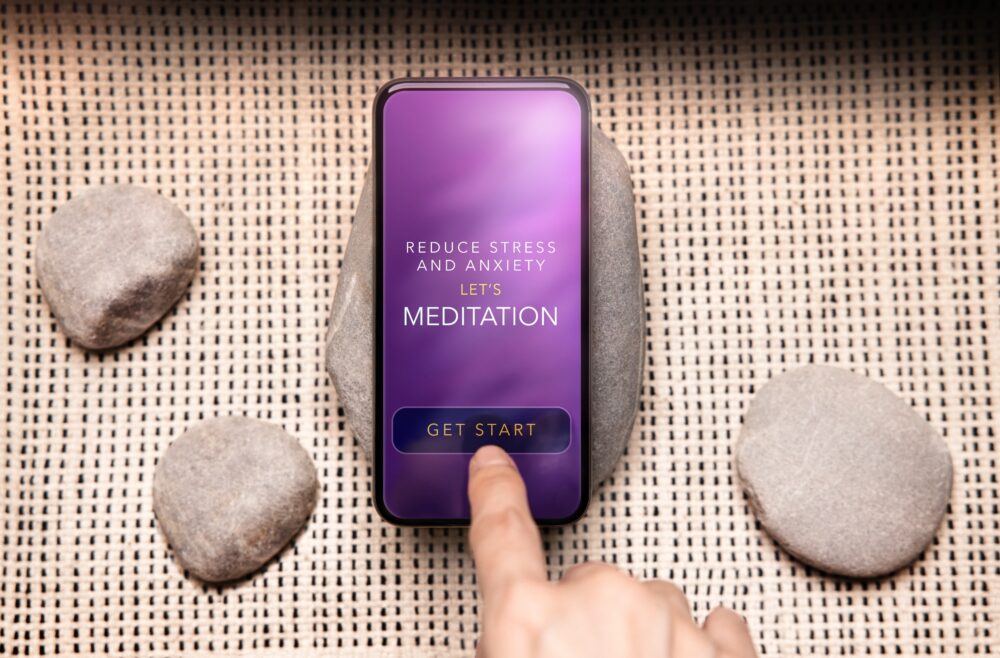
For years I tried to learn how to meditate. I wanted to gain all the benefits I kept hearing about in the news and online. Reduced stress, better coping ability, better sleep, increased happiness, and an overall ability to deal with the world more healthily all sounded great to me. But no matter how many books I read, videos I watched, or YouTube courses I tried to follow, I just couldn’t master it. I even tried a meditation group for a while, but that turned out to be more social than useful. My brain would never shut up and inner peace remained elusive.
As a last-ditch effort, I decided to give meditation apps a try. You’ve probably seen advertising for at least a few of these somewhere. Calm and Headspace are two of the biggest, but there are plenty of others out there. Some are created/sponsored by celebrities, authors, or gurus. Others are created by scientific or academic groups, and some are simply corporate-owned. Some teach a specific form of meditation, others include many. Some offer things in addition to meditation (courses/podcasts, sleep stories, soundscapes, etc.), while others focus solely on mindfulness.
The one thing they have in common is that they aren’t cheap. Most offer annual subscriptions that run close to $100 and in some cases much more than that. That can be a lot of money to drop on something that might help you, so it’s best to learn as much as you can before you open your wallet.
I tried a bunch of them, but I can’t tell you which one is “best.” That will depend on your likes/dislikes and what you want to gain from a meditation practice. However, I can tell you that I ultimately paid for two apps (Calm and Headspace) and share with you the thought process I used to determine whether or not any of these would be helpful/worth the money.
- As noted above, my motivation to try apps in the first place was because everything else had failed for me. Before paying for an app, exhaust all free options, first. Try some books from the library or some free online courses. There are also some streaming courses, so see if a service you already subscribe to offers something. You may also be able to borrow a DVD or audiobook from the library. If there’s a free meditation class in your area (via a senior center, extension program, library, or the like), try that. Or if you have a friend skilled in the practice, ask them for some help. You may have more success than I did with these options.
- You know yourself best, so if you know you learn best via in-person instruction, an app is probably not the best option for you. Direct the money for the app toward the fee for an instructor. My learning style is 50/50, meaning I can learn either way if the instructor resonates with me. I could not find a connection with an instructor in my area, so an app became another avenue to pursue. If you can find a great in-person instructor and that works for you, your money will be better spent there.
- If you decide to try meditation apps, try the free trial, first. Most offer some sort of free trial, although some limit the content so much that it’s hard to get a sense of the app as a whole. If the app doesn’t offer a decent trial, try to find someone who has used it or reliable reviews. Don’t pay for something if you aren’t reasonably sure it will work for you. (Prepare to invest some time in this process. There are tons of apps out there to try and it may take a while to test out even your top ten choices.)
- There are some fully free apps out there. Insight Timer is the best of the freebies that I found. Even if a free app isn’t perfect for you, it can be a good way to make sure you can commit to a meditation practice and see if an app will be at all helpful. Try a few freebies. If you find one that works for you, that’s money saved.
- Do you need to pay for the full version? Make sure you understand what any paid option offers. It may be a bunch of features you’ll never use. (And be honest with yourself about what you will and won’t use.) At worst, you can always subscribe later if your needs outstrip the free version.
- Does the app offer things beyond meditation that are useful for you? Some apps are strictly for meditation, while others incorporate sleep aids, soundscapes, music, courses on other mental health-related subjects, and podcasts. If you will use those features, then the value of the app is increased and may be worth paying for. Don’t pay for more than you’ll use, though. I find great value in the sleep aids, so Headspace and Calm were worth it to me for those extras.
- Match your app choice to the type of education you’re seeking. Some apps focus on specific forms of meditation, while others are more general. The teachers on any given app may or may not have a style that matches your needs. Educate yourself on the various meditation forms to make sure your app of choice is teaching you what you want to know.
- Make sure the app supports your goals for meditation. If you just want to ease some anxiety, a simple, beginner-level app may do the job. However, if you want to develop a deep practice or grow an existing practice, you may need a more specialized app or in-person instruction.
- Meditation is about getting away from the digital world and getting in touch with your inner life. An app may be counterproductive to this for you. For some, it can be a help, but for others, the digital distractions are too much. (You know the drill. You bring up the app, but then a notification pops us so you see what that’s about, and then three hours later you still haven’t meditated.) If you do use an app, you’ll need to silence all other notifications so you aren’t interrupted. Some people might prefer to stick to meditating the old-fashioned way and leaving the phone in another room.
- As with anything of this type, you’ll get out of it what you put into it. Simply installing the app on your phone and paying the fee won’t make you a meditation master. You have to use the tool. If you aren’t committed to the practice, the app is a waste of money. Make sure this is something you’re committed to before shelling out the money. If you require accountability to stick with something, go with an in-person option. An app isn’t going to care if you show up or not.
In the end, I’ve been relatively happy with the two apps I chose, although I doubt I will renew Headspace when my paid year is up. I found that one great in the beginning, but I’m quickly outgrowing it. And that’s fine. I got my money’s worth out of it. I’ll probably keep Calm because while I’m getting better at meditating even without an app, I value their sleep aids enough to keep paying for those.
While I haven’t yet unlocked all the peace that meditation promises to offer, I am meditating more often and more successfully than I was before. My blood pressure is lower and I find my anxiety is easier to deal with. I find that I’m generally calmer and less reactive, which is nice. These apps have helped me, but they may not help everyone. Before you spend the money, make sure you think it through. However, for the right person and in the right circumstances, meditation apps can be worth paying for.
Read More:
- 18 Free And Inexpensive Ways To Fix Your Sleep
- No More Excuses: Even Small Amounts Of Meditation Can Relieve Stress
- How to Chill Out On the Cheap
- Need Mental Health Services: Here Are The 7 Best Telehealth Apps For Your Mental Well-Being
Come back to what you love! Dollardig.com is the most reliable cash-back site on the web. Just sign up, click, shop, and get full cashback!

Jennifer Derrick is a freelance writer, novelist and children’s book author. When she’s not writing Jennifer enjoys running marathons, playing tennis, boardgames and reading pretty much everything she can get her hands on. You can learn more about Jennifer at: https://jenniferderrick.com/.
Comments